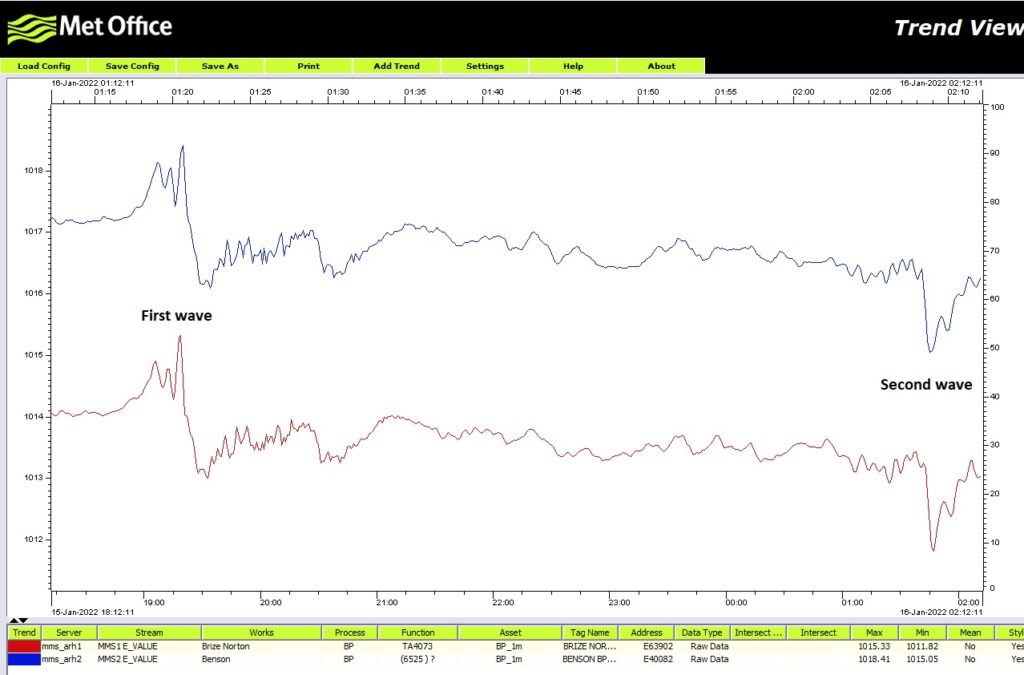After a presentation to BAS on the Obsession 22″ I opened the dome and set about imaging M61 RGB. I managed to take 6 x 300s of each channel at Gain 139 Offset 21 Temperature -25℃ before the dome closed around half past midnight, not sure why.
Category: IMT3b
Viewing Report 23rd March 2022
19:14 – 21:43
Another clear night, so many in a row and a lovely warm spring day of 18℃ I’m out again 🙂
I’m grabbing some more M61 luminance tonight before I move onto RGB. Some teething problems made me start much later than desired, including a cable coming out the back of the mount for the power to the QHY168C, not sure why. So I did not get going until around 8:30pm.
I managed to grab 21 luminance frames at 300s until around 11:30pm when the the guider lost it’s stars. This is a setting problem as it was clear all night. I knew before I went to bed that there was an issue as I had seen the guider stop guiding. I will take a look at it and calibrate the guider using guider assistant after BAS tomorrow night.
Viewing Report 22nd March 2022
21:00 – 22:00
Let the 12″ run for 3 hours imaging M61 luminance so went to bed, took 36 images Gain 139 Offset 21
Viewing Report 21st March 2022
19:00 – 21:17
A quick imaging run this evening, again for NGC 1999, this time LRGB, 5 frames of each at 300s then it was too low and my bed time on a school night 😉
Before shutting down I made sure the Tak 102 profile for the dome was correct for the 120 Esprit as it is fixed on the same side of the 12″. I then slewed and it centred fine and the dome was in the right position. I tweaked the focus too in preparation for the Messier Marathon with Basingstoke Astronomical Society this Friday.
Viewing Report 20th March 2022
20:00 – 21:52
After a glorious sunny Sunday where I spent a lot of the day building the new decking for the Summerhouse for my wife, I planned on a short, sharp observing session until 9:30pm (turned out to be nearer to 10pm) starting after dinner at 7pm. In preparation for this I setup the 22″ dob on the observing patio and opened the dome for the 12″ to start to cool down whilst I ate with the family. My daughter and her boyfriend’s famous pasta dish was for dinner tonight which was great 😋
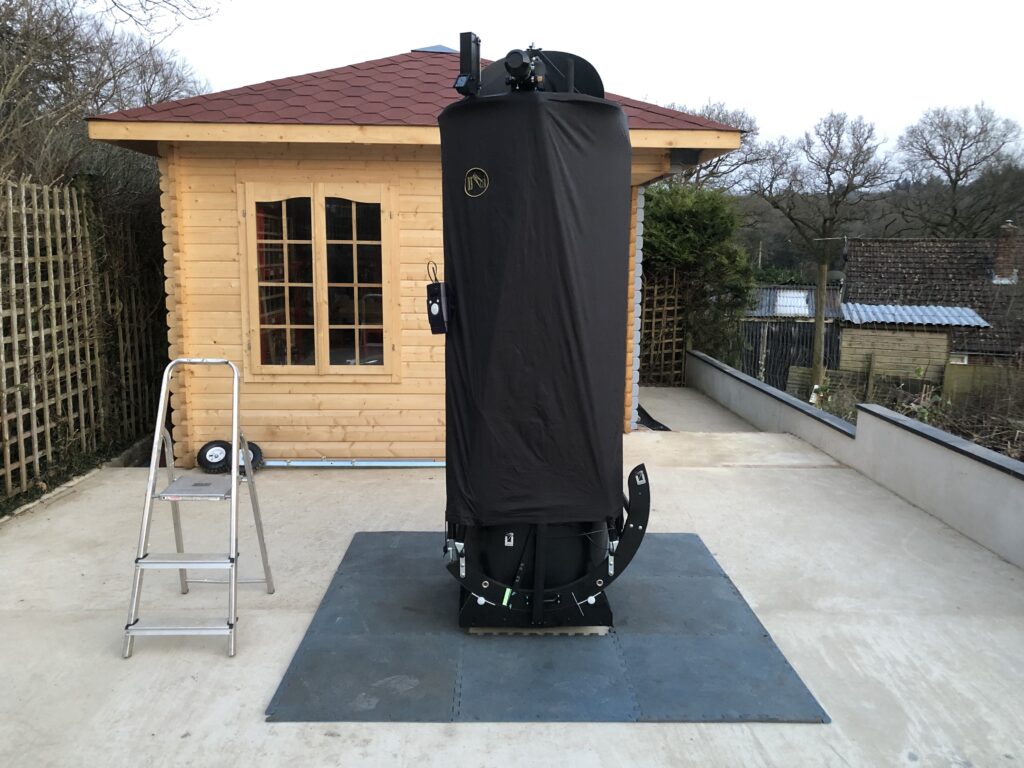
With dinner finished I headed to the sofa and set the 12″ running on NGC 1999 in Luminance so I could then go out and observer with the 22″. It took a while to do the usual, sync and centre on a star, get the focus right and set the imaging run up. But after 45 mins I was then able to wrap up warm and head outside.
I have read an article in Sky and Telescope of visually observing NGC 1999. With that information I opened my newly acquired Interstellarum Deep Sky Atlas to look at the area where NGC 1999 resided. I then referred to the Deep Sky Guide to look at the photos and drawings of the objects in the vicinity including this reflection nebula.
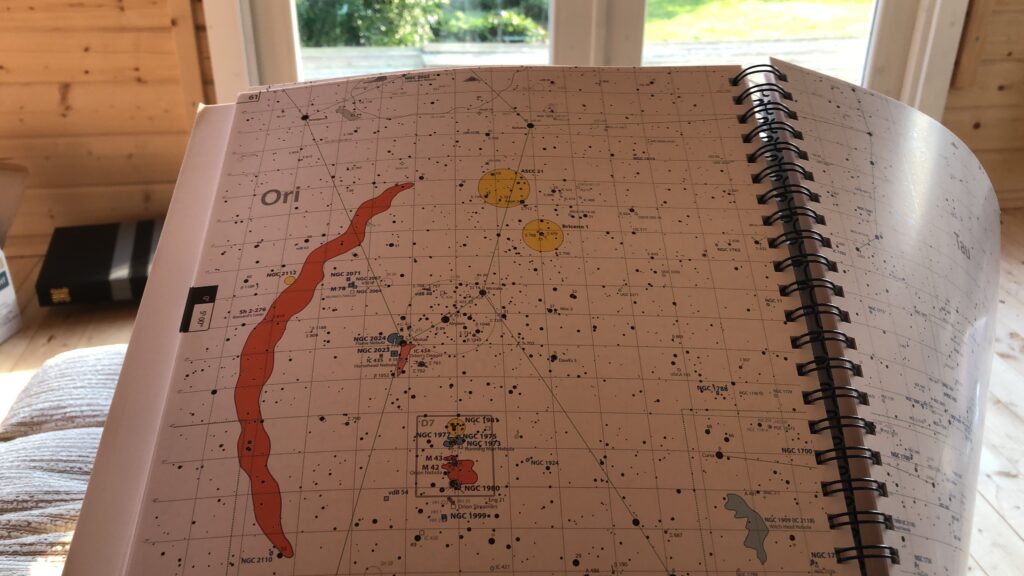
There was a potential to observe two Herbig-Haro (HH) objects but I was afraid the sky would be a little to bright given the Moon rising at 9pm, in order for me to see them. I placed the 31mm Nagler in the 22″ and then dialled in NGC 1999 into the handset and pushed the scope until the numbers for Azimuth and Altitude were as close to zero as possible and looked through the lens. Surprisingly I could see a small fuzzy object with a star embedded to one side just off centre in the eyepiece. I reviewed the star chart on my phone using Sky Safari 4 and confirmed this indeed was NGC 1999. I guess it was just off centre due to my alignment and next time out I will use the 13mm Nagler to centre and align the scope during the initial setup.
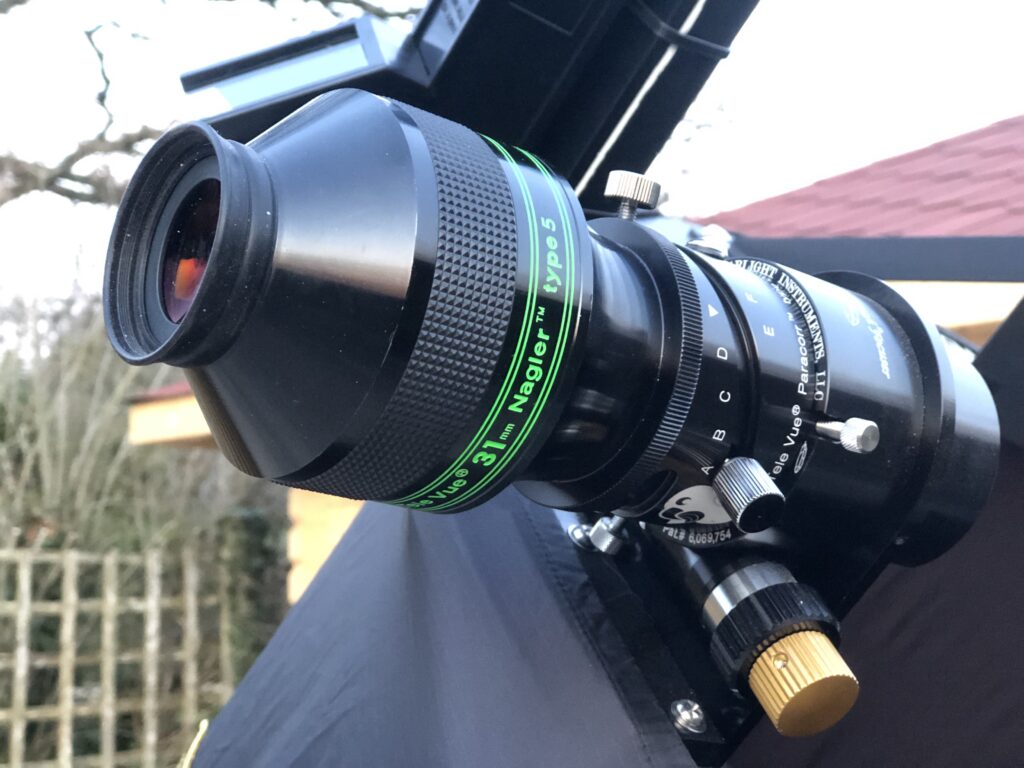
On looking at the reflection nebula I could tell there was something to one side of it due to the offset nature of the nebula to the star. I changed to the 13mm Nagler and set the Paracorr accordingly back to H from the A setting for the 31mm Nagler. I then recentred using the Argo Navis computer and too a peak through the eyepiece. I could now see a distinct whole in the nebula, but clearly not as good as the Hubble image I had looked at, however it was there. I ten went looking for the two HH objects but I must say I could not confirm them at all. There were two star like objects near by but again looking at my Sky Safari star chart I was not convinced. I would leave this for another night when the Moon was goner and I had cooled the mirror with the fan, that is still not connected to power yet.
For a laugh I then pushed to the Horse Head but could not see it, not surprised given you need a Ha filter. I will buy one.
I then had a quick look at M42 again which is a wonderful sight in the scope. Orion was now getting low with NGC 1999 and M42 at +18 degrees at about 9pm. I then started to pack away the scope to head in doors and look at the 12″ and see how it was doing.
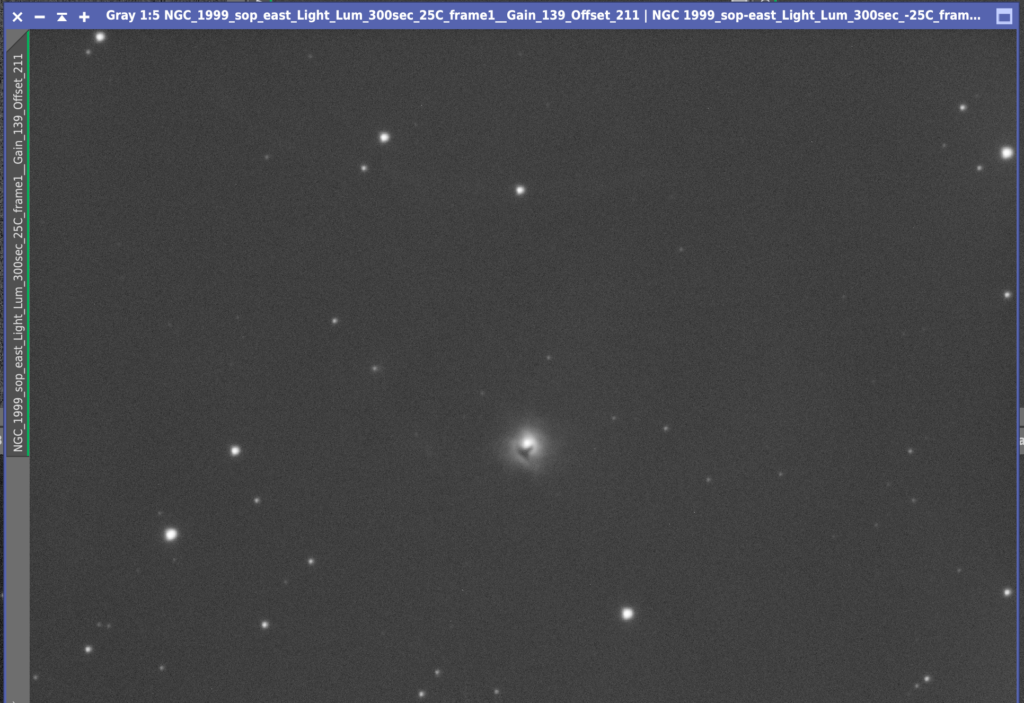
I reviewed the set of images for NGC 1999 on the 12″ and now due to the altitude I switched and set the scope running on M61 for Luminance and RGB as it is on my list for my Messier wall chart.
At 10pm I left the dome capturing M61 LRGB frames and hit the sack.
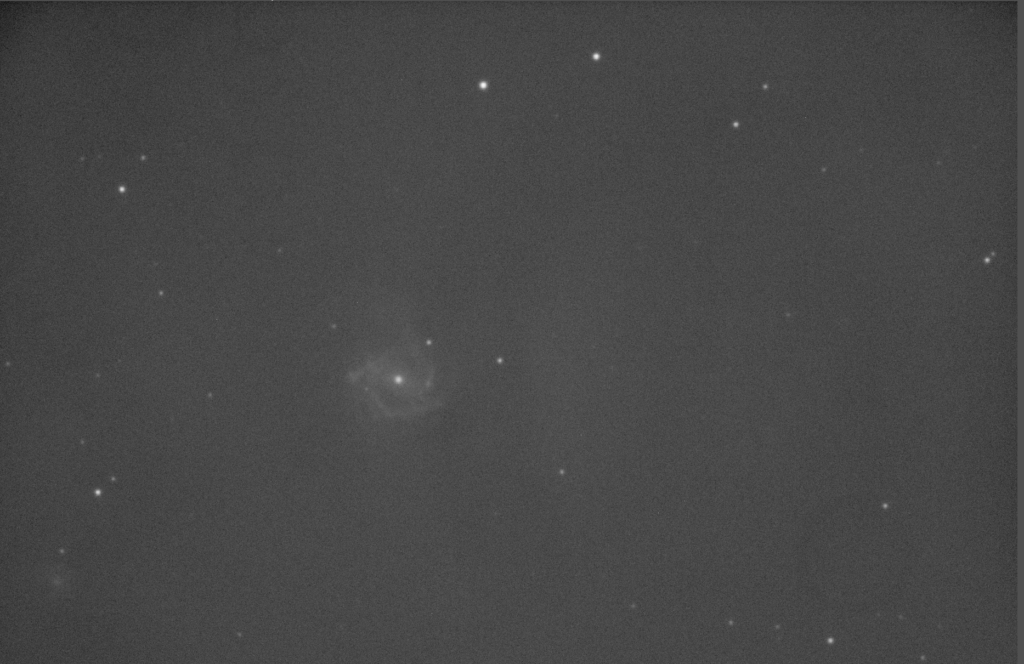
Exoplanet HAT-P-66b (25/2/2022) – IMT3 + Visual with 22″ Dob!
21:24 – 03:00
So for the first time in a while the observatory is back up and running and it’s Friday and it’s clear! So Bob came over and we set about imaging an exoplanet and getting the 22″ Obsession dob out of the warmroom where it had been sitting since November, and moving it down to the observing plateau by the IMT3b observatory.
A few nights back, during the week I had managed to get the 12″ in the dome balanced with my original 2004, 5″ Skywatcher 130 reflector as a guide scope and the Skywatcher Esprit 120 ED on the other side. The 5″ now guides, however the QHY camera on the 120 is not currently connecting so I need to investigate. Also the MEII hand controller is sending erroneous signals to the mount so I needed to disconnect as it kept saying ‘joysticking’ and moving the mount. Unfortunately the 5″ was pointing at the dowel so I used off-axis guiding instead.
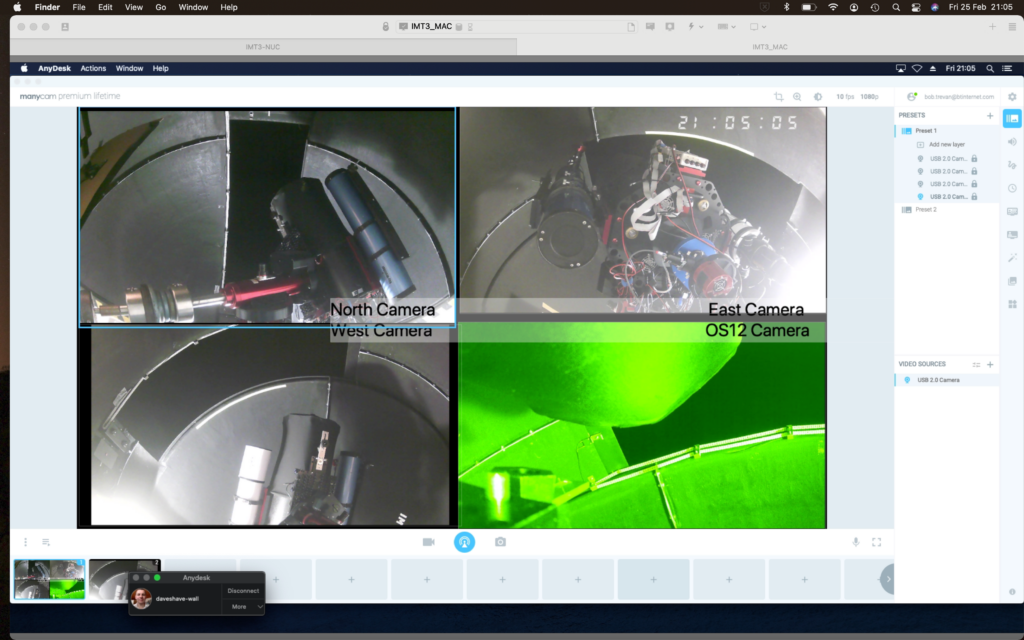
I selected an exoplanet on the Exoclock website, and set about imaging. Unfortunately due to my profile on exoclock being set to UTC +1 and me not noticing I started 45 mins into the transit! I will now use this as a test run and process the data and submit.

So first up was moving the 22″ down to the plateau so it could cool down. I had planned on taking it back up to the Warmroom, however it is so heavy I have decided to keep it in the workshop. I will make sure I connect the electric up for the workshop this weekend thus allowing for the new dehumidifier to be switched on and operational.

Whilst the 22″ cooled down, we went back indoors and setup the 12″ in the observatory to image the transit. The focus point was 25,000 and I made sure I selected the Red filter. I slewed and aligned on the exoplanets host star and then settled on a 5min exposure due to the low brightness. I started imaging at 9:24pm, the transit start was 8:45pm 🙁

Whilst imaging continued we went outside and set about setting up the 22″. Things I learnt from this first public outing were;
- Remember to put the shroud on
- Remember to pub the secondary shield on
- Remember to collimate the secondary first
- Remember to fit the Telrad dew heater
- Remember to find a 40mm eyepiece
- Remember to download and print the Parracor chart
- Remember to set the Parracor to the correct setting
- Remember to buy a 12v battery powered hair dryer
- Remember to buy a secondary dew heater
We collimated the scope and then went on to look at M42 which with the 24mm Panoptic looked great. We then slewed to M45 the Pleiades but of course the open cluster is too wide for the for I was using. Then we tried find M81 and M82 but I found this difficult due to the lack of bright stars in the area. So instead we went to the Trio in Leo.
M65 and M66 looked fairly bright and you could make out the dark dust lane in M65. NGC 3628 was visible with direct vision, however with adverted vision it was much easier. It appeared very long and thin.
We had to use s hairdryer on the secondary a lot. The Telrad also dewed up as did the eyepiece. The primary mirror was fine, although with direct headtorch light looked like it was dewed, but upon inspection this was not the case.
At midnight it was time to pack up before I had to do a meridian flip. Bob helped my dismantle the 22″ dob and then place inside the workshop. I could not move it into the room without dismantling which was a shame. It is far too tall.
Once done, Bob headed off home for a well deserved rest and to warm up due to it being 0℃. I headed indoors and performed the meridian flip at 0:23am.
I then left the observatory running until 2:30am whilst I wrote this blog, had a glass of wine and ate an easter egg 🙂 I also went back out to the workshop to tidy up the telescope eyepieces etc that I had not put away.
At 3pm I went on to take luminance for M85 that I needed to complement the RGB data I had processed. I let this running and went to bed.
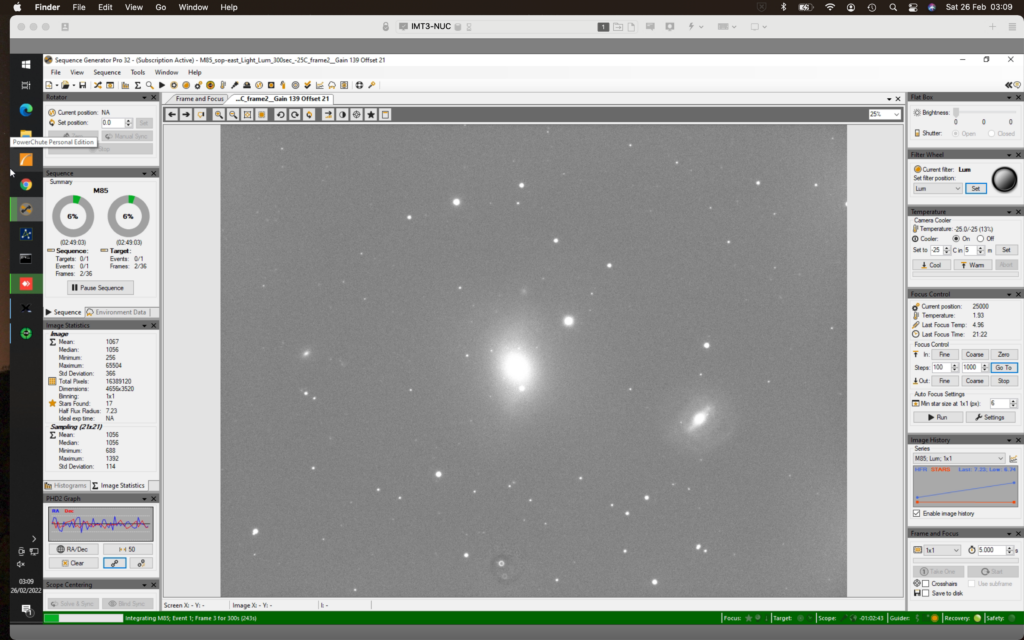
I took flats and dark flats in the morning, although I had to increase the exposure to get the required level for the flats. This is strange as they should be the same. I am now concerned the camera my be playing up and causing an issue. I will investigate.
Viewing Report 5th January 2022
17:00 – 02:15
went out and put ZWO ASI120MC on the back of the ST80 guide scope. Refitted the Lodestar to the off axis guider. I then setup the FoV indicator on TSX and also got the guider to focus.
Took a bunch of M78 frames LRGB to start with. Then tried a 600s Ha but that showed very little.
Then joined by Bob joined and he reminded me to image JWST.
Then around 12:30am I started imaging M78 again on the other side of the meridian. I must sort out imaging with a frame so that it is easier to get the object inside the FoV and lined up as it took me quite some time this evening. Plate solving was also not working again within SGP so I need to look at that on the next night out.
Detecting pressure waves from the Tonga Eruption (2022/01/15)
On January 15th 2022 at 15:10 AEDT (04:10 GMT) the Hunga Tonga Hunga Ha’apai underwater volcano near Tonga erupted. Hunga Tonga-Hunga Ha’apai is 1.8 kilometres tall and 20 kilometres wide, but most of it is underwater, with the top 100 metres visible above sea level. The pressure wave generated by the explosion blasted through the atmosphere at more than 1000 kilometres per hour.
Dave mentioned to me that the people had registered a pressure increase on their monitoring devices due to the pressure wave and checking the internet the Met Office has issued a nice graph on Twitter.
On the observatory Grafana dashboard I could indeed see two pressure waves at the correct time. We only record the pressure every 60 seconds because for astronomy that’s all we need so we do not have the resolution of others but the height of the two events are in the correct range compared to the graph above.
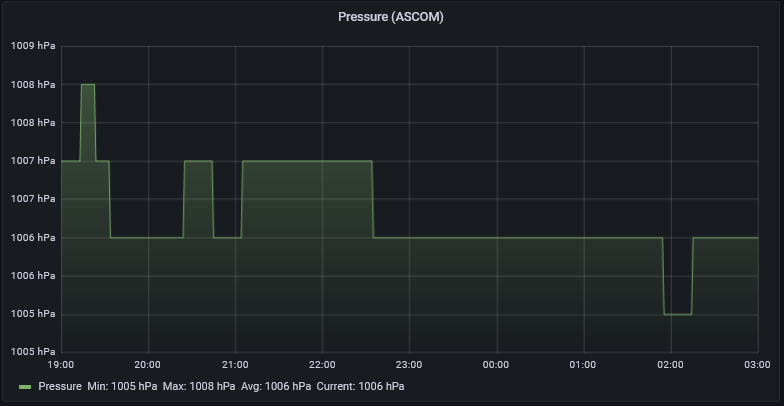
The first pressure wave arrived (19:13-19:24) we was 2hPa increase as we have lost some resolution due to sampling period and the Met Office is ~2.5 hPa. We could change the sampling to be lower (15 or 30 secs) as storage is not an issue and then we would have caught a nice defined peak. The second pressure wave (2022/1/16 01:55-2:14) and we measured ~1hPa drop and again was lower than the Met Office due to our sampling period.
Our auxiliary pressure monitoring install was down during this period as the box appeared to have been restarted/rebooted and the ASCOM Alpaca instance was not running which was unfortunate 🙁
Viewing Report 4th January 2022
17:53 – 02:34
Clear night! So I’m going to setup and let the dome run all night if it stays clear which is the forecast as I have work tomorrow.
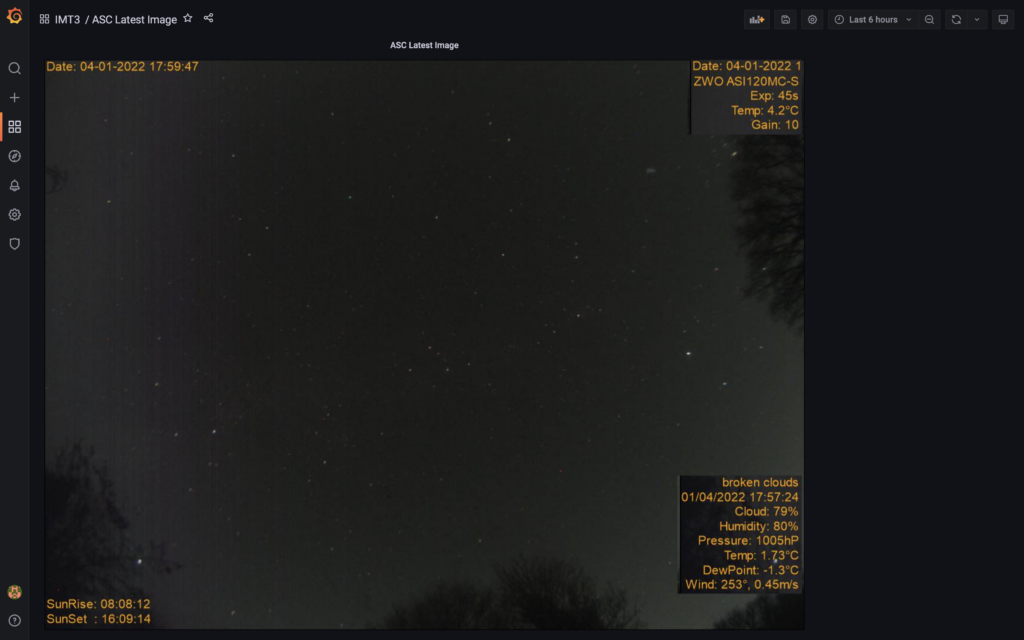
I have run the guiding assistant on PHD2 so that I can hopefully better track objects. The drift in frames from the last time out whilst using the ST80 as a guide scope was less than ideal. I have now put al the new settings suggested into the PHD setup and have swung round to do a focus run on a star near to M32.
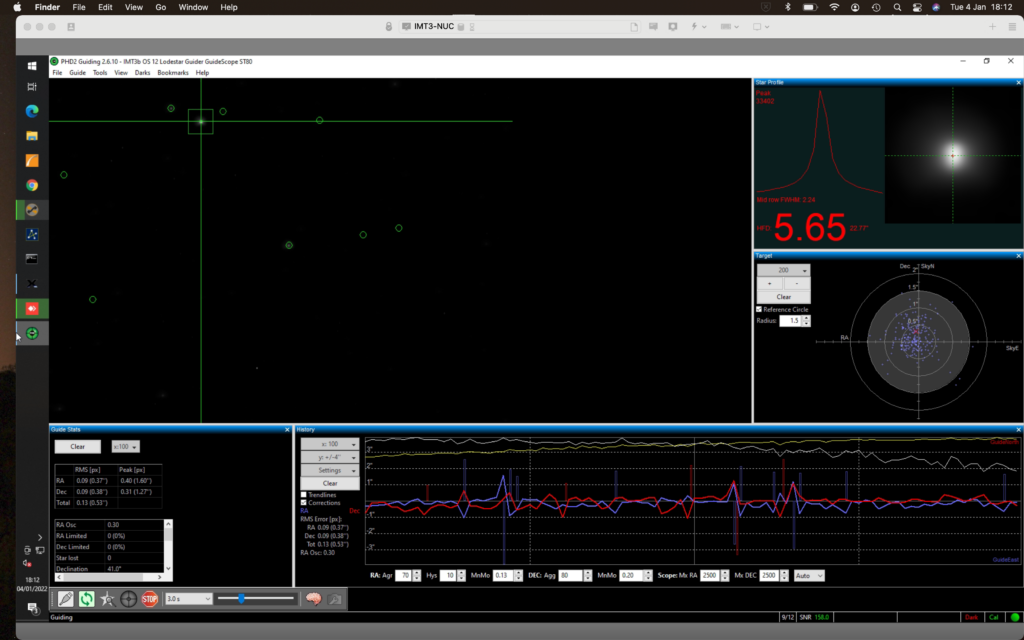
After successfully running autofocus in SGP at 23,560 on Luminance I have now slewed to M32 to gather more data that is desperately needed to resolve the outer spiral arms of the companion giant galaxy M31.
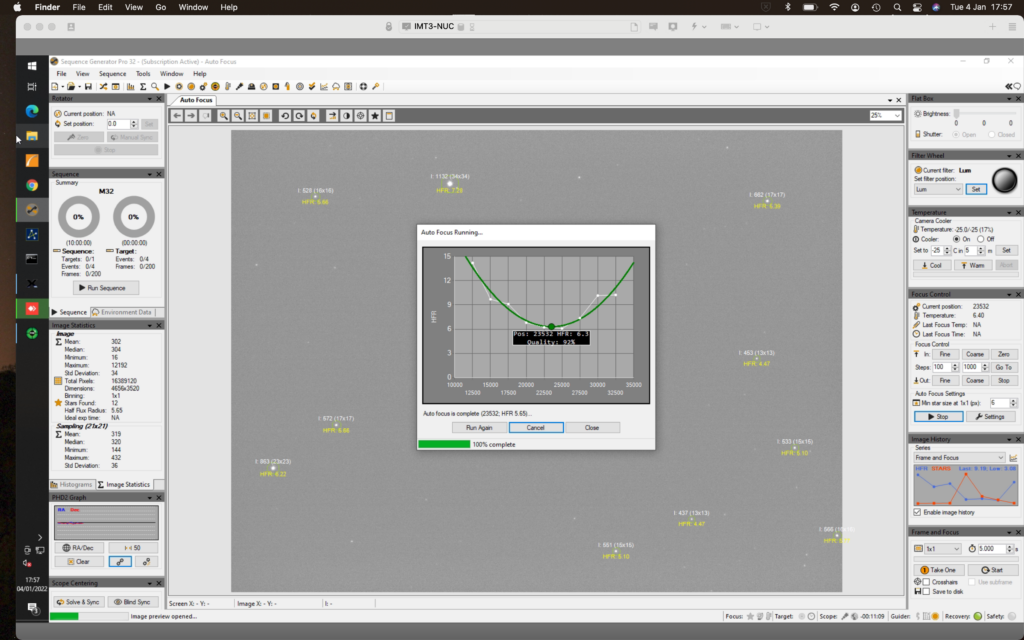
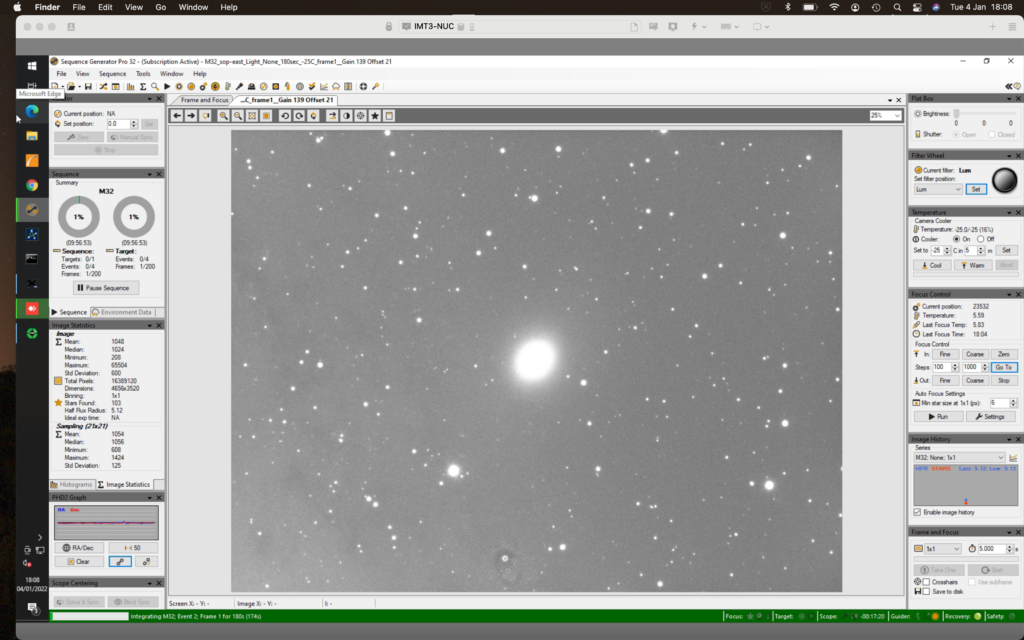
So it is now just gone 9pm and whilst the guiding is managing to stop trailing of stars, the image is moving between frames, enough to loose the object over the course of 4-8 hours. This is clearly not good enough and it does look like the focal length of the ST80 is simply not long enough.
To get around the problem this evening I have turned guiding off, as the exposures are short (3 minutes) the trailing of stars is not an issue. At midnight I took flats for M32. I then centred on M78 for the rest of the night. Before starting I performed another focus run as the focus point had changed over the night with the temperature drop.
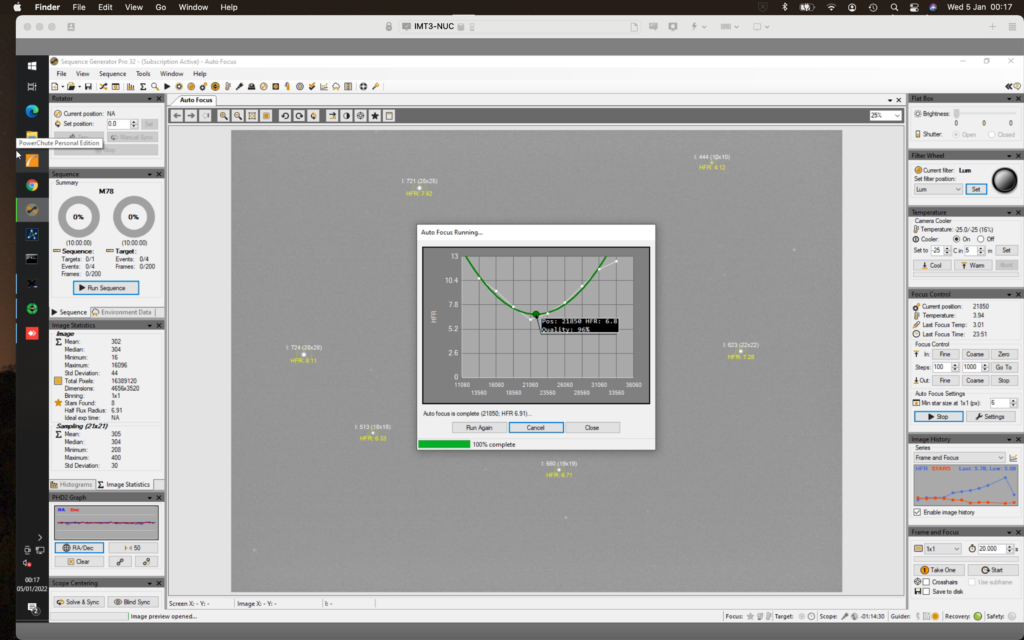
I choose the same exposure settings and Gain 139 and Offset 21 settings as for M32. -25C was the temperature but this time I rotated the camera by 90 degrees to also fit in NGC 27309.
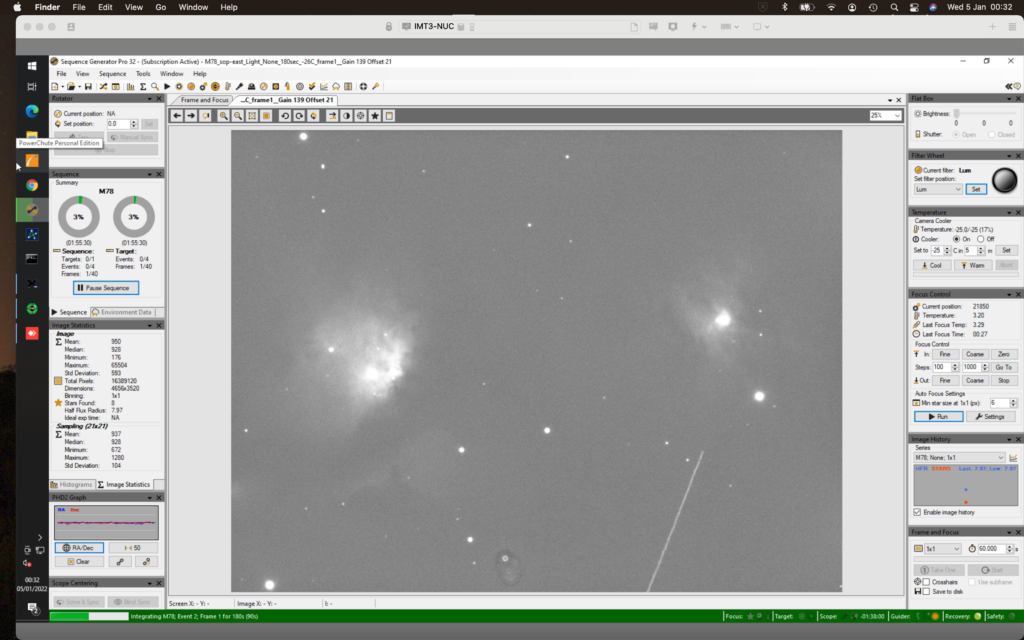
So I left the scope running and it completed at around 2:30am with 40 frames taken across 4 filters giving me 30 minutes per channel. This will be enough to get started and if clear tonight I will setup for another run at M78 and hopefully improve the guiding.
Update. On reviewing the files this morning it looks like I forgot to select the filter in SGPro which means all my M32 and M78 images from this evening are in fact luminance only! Which is ok for M32 but for M78 I need some colour. Below is the weather data for last night.
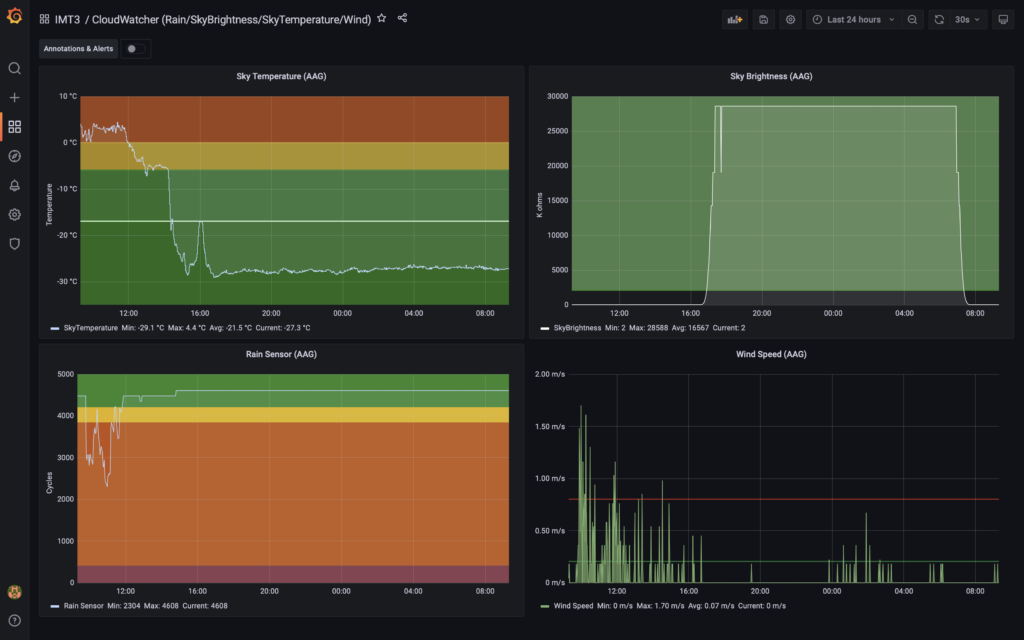
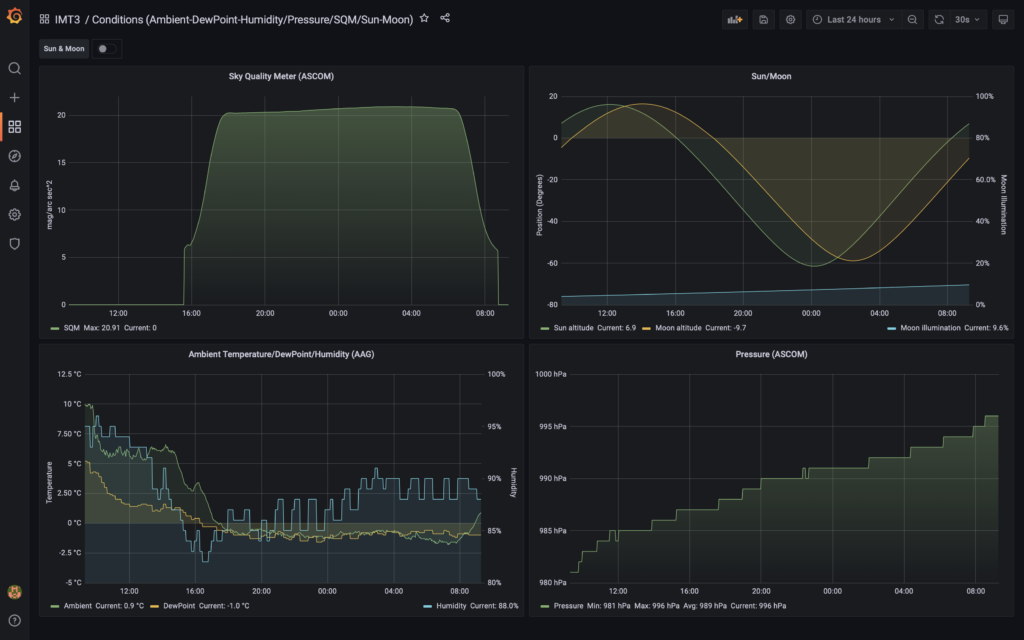
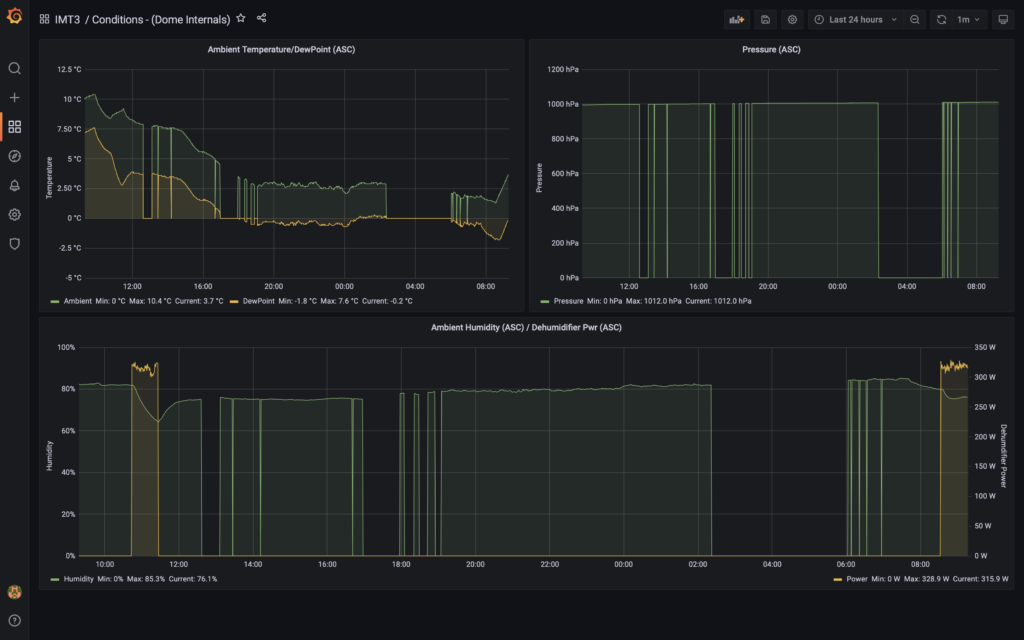
Viewing Report 2nd January 2022
19:26 – 01:30
I started with M76 Ha as I need some frame for this object. I already have many hours in OIII. However after starting to image I realised the guiding, which is currently being tested through Dave Boddington’s ST80 was not pointing through the slit correctly as M76 was near the zenith. This means I have suffered from trailing as the guider was trying to guide on long stars due to diffraction.
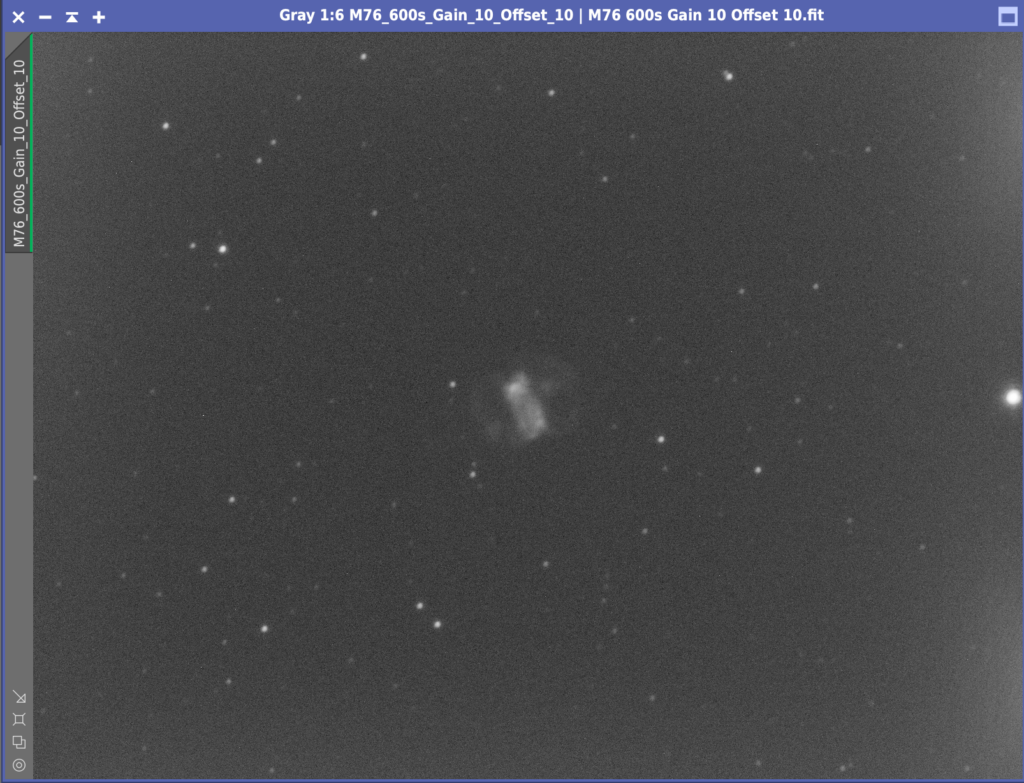
I swapped to a different object, this time M32 as I have not imaged this directly before, just as a happenstance of imaging M31. I have chosen 180s exposures using Gain 139 Offset 21 to keep the saturation of the core down. At 300s the core was blown out.
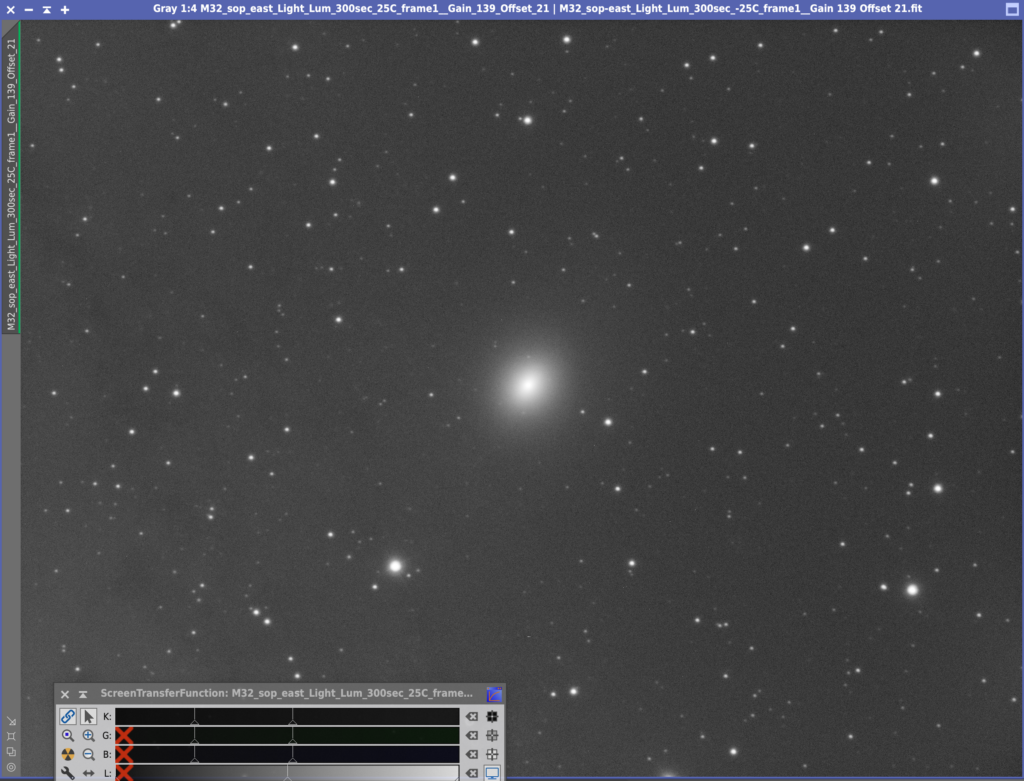
M31 can be seen to the left and lower left of the small galaxy. M31 covers a large part of this image! So how well was my guiding doing?
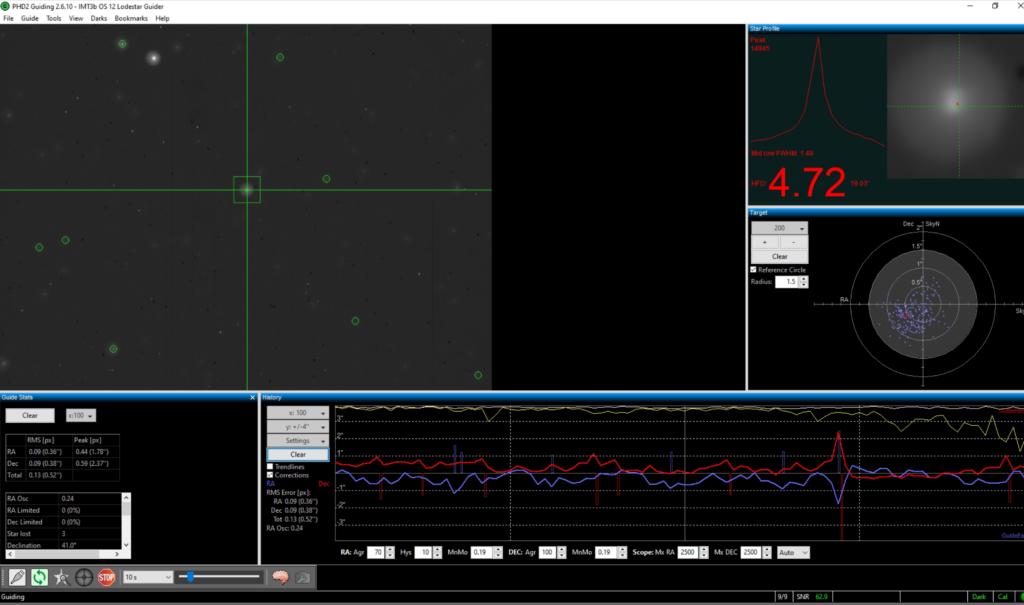
The guiding looked fine. 0.52 arcsecs total error which I am happy with. I stayed up until just before midnight and then left the observatory running. In the morning I noticed the dome shut around 1:30pm due to the images after that looking like flats.
I also noticed this morning that the images were drifting so the guiding is not quite right as the image drifts. I will next time out run the guiding assistant and see if that helps.
Update the image scrubbed up fairly well but I lost a lot of frames to drift and trailed stars and then the dome closing. Resulting image around 3 hours 12 minutes exposure of which 48 mins was Luminance but there was cloud affecting many frames.
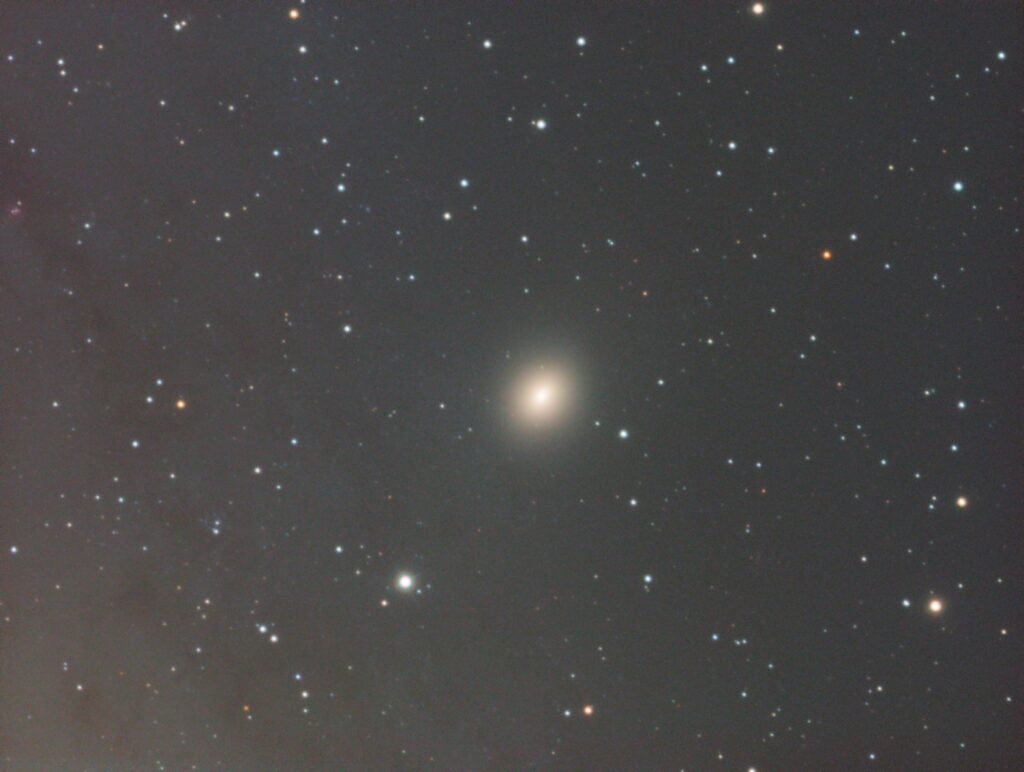
Below is a copy of the nights weather data.
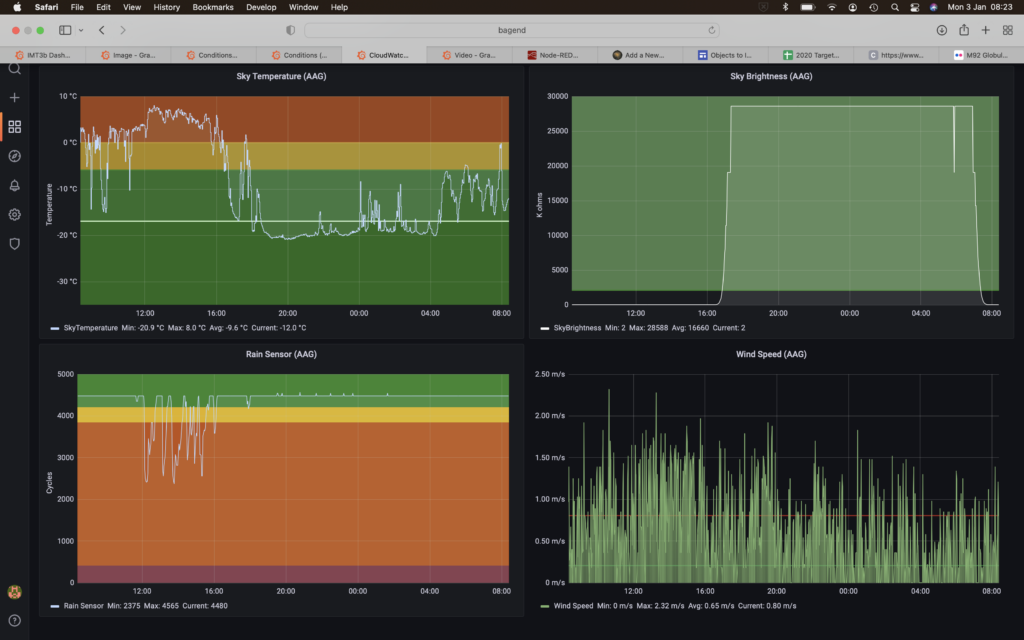
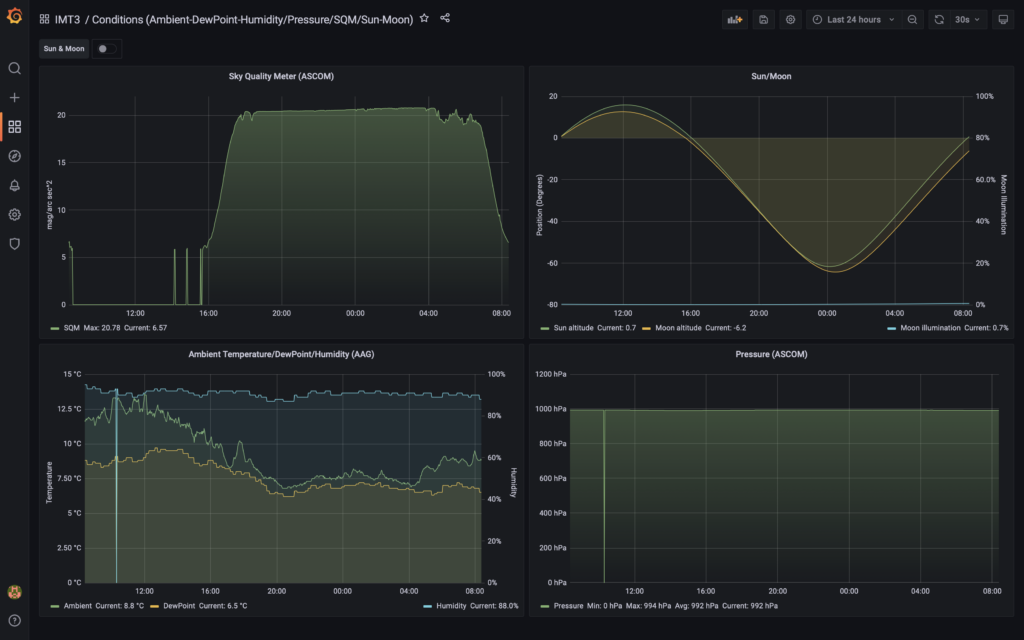
Viewing Report 10th December 2021 – IMT3
04:00 – 06:53
Comet C/2021 A1 Leonard. The last day to get this lovely little comet. Dave Boddington had captured a wonderful image yesterday through his 6″ and 4″ refractors. I was was never going to be able to do that with my 5″ refractor due to my broken foot and not being able to move it from the Warm room to the verge on the other side of the lane at the front of my property.

So instead I settled for the good old Canon 6D on a tripod. I had slowly gone up and retrieved the kit the day before in the light and now at 4am set off out the front, crutches in hand, camera on tripod strapped round my neck, in the dark at 1℃.
After getting comfortable standing on the verge, I extended the tripod legs balancing on 1 foot and set the camera on Arcturus to focus at 100mm. I had chosen the 100-300mm lens for maximum flexibility. After achieving focus by hand and by using the zoom function on the camera screen, I placed the camera roughly in the direction of where the comet should appear just below Corona Borealis in the faint constellation of Serpens. This is the shot I got.
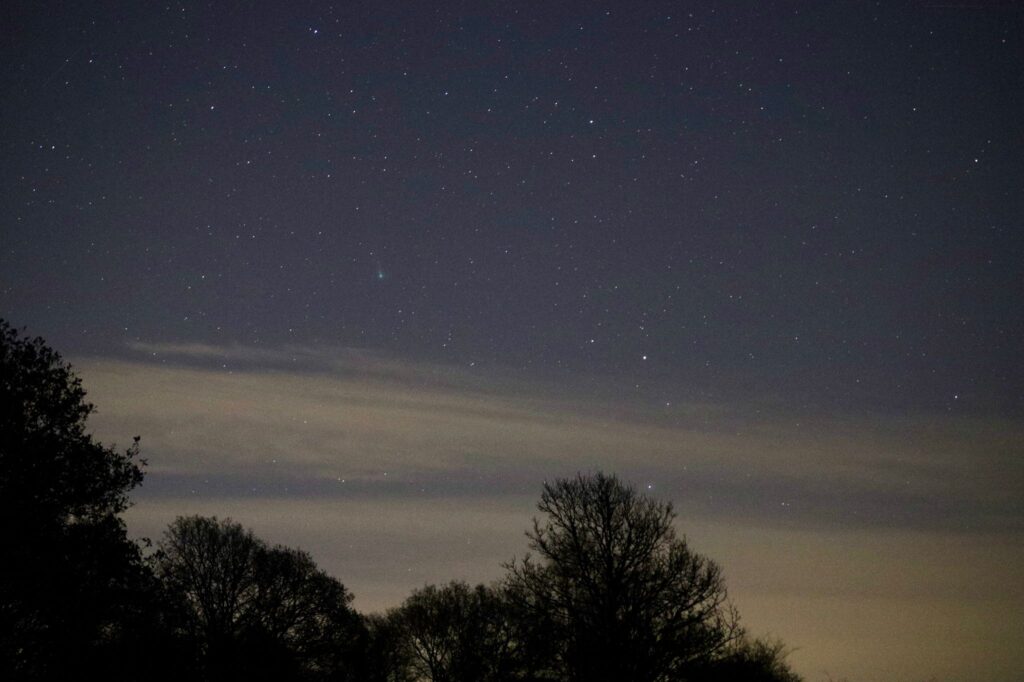
I then changed focal length going to 300mm on the zoom lens, switched back to Arcturus to focus and then, after a few attempts, actually some 20 minutes, I managed to get the comet back on the chip. Result!

I packed up the tripod, hung it round my neck and headed slowly and gingerly across the lane and back up the drive to the house. When I had removed my one shoe, cleaned my boot and my crutches I looked at the camera lens and was not surprised to see a lens full of dew 🙄
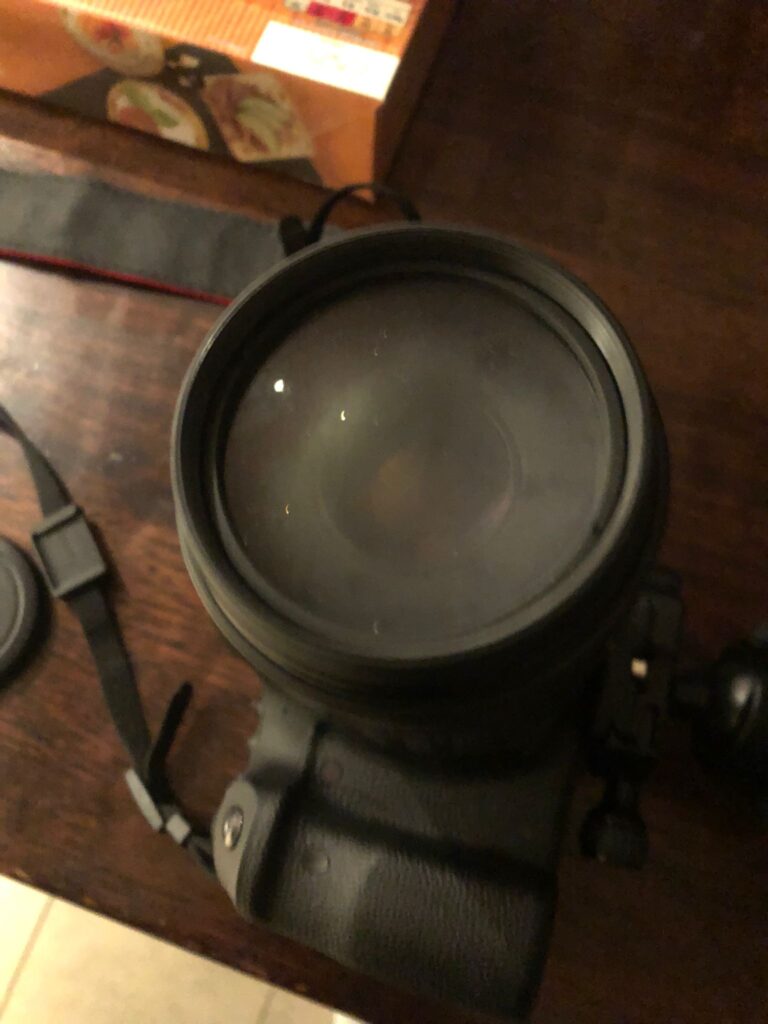
I then set about opening the dome of the observatory as the comet would have now cleared the tree line. However it would not open 😳 On closer inspection, meaning I went back out in the cold and up the garden, I found the shutter would not operate. Some time spent investigating led me to believe the battery in the shutter box was dead 🥺 so I removed and took back to the house for further investigation later today. That meant no comet photo through the 12″, however I was pleased with my results given the challenge.
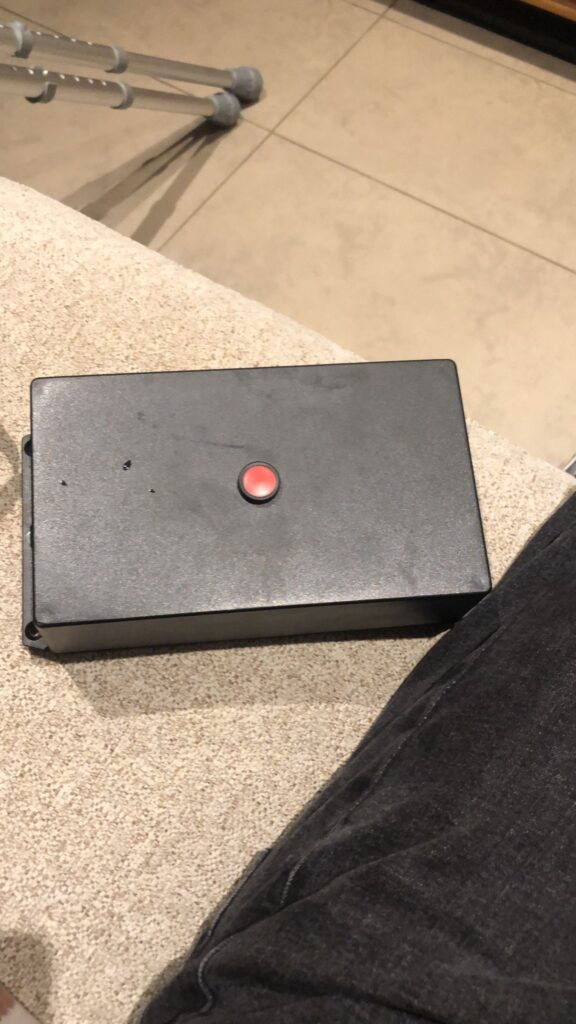
Viewing Report 2nd November 2021 – IMT3
20:00 – 21:30
IC5067 Pelican in OIII and SII, rotated to new angle to allow guide star on West side of the mount. 10 x each channel at 600s and Gain 139 Offset 21, left running and dome shut later in the morning.
Rotation angle 218 from SGPro plate solve, 171.750 from TSX
Flats done the following day 3rd Nov.
Flats darks and darks still to be done
Viewing Report 31st October 2021 – IMT3
21:17 – 00:28
Progress meridian flip tonight. Nearly worked, challenge was I lost the only guide star and then it fixed on hot pixel. I have now made the setting for star recognition min 3 HFD but still not guide star present. I need guide scope……
Viewing Report 8th October 2021 – IMT3
22:30 – 03:57
Tonight I am at Kelling Heath star party with Shane and Mark Radice. After a fantastic board game with Mark, Shane and Shane’s wife we then headed back to camp and I started to look through there binoculars using the NSOG (????) book as my guide. Whilst I realised I could have got away with bringing the Milkway edition, instead I brought along the Autumn/Winter version.
I had packed my 100mm Altair Astro binos so it was going to a visual night with some rudimentary drawing. I looked around and set my gaze on Pegasus and turned to the pages in the guide to set me off.
First on the list was M15. It appeared relatively close to
m15 – seen
peg 1 – seen
3 peg – seen
53 peg major seen not companion
ngc 7217 – not seen
ngc 7331 – seen with averted vision
ngc 7332 – not seen
ngc 7814 – not seen
M39 seen
M42 seen
veil eastern seen
North American seen
tried UHC filter baader from Mark in 1 eyepiece in binos abs made nebula stand out
bed at 3:52am due to fog and 9deg c
looked at M81 and M82 through Keith’s 18”
could not see horse head
M42 WOW!! and M43 both through 13m Ethos 100 deg and then 21m Ethos
Viewing Report 5th October 2021 – IMT3
19:21 – 21:00
NGC 6765
Focus 18,406
imaged for 1hour 36 mins and then the safety went off and it stopped imaging, no idea if the dome closed at that point or if it just lost a guide star but that was it, despite it being clear all night. So I need to not set the Boltwood OK to image setting in SGPro and I need to find a way of time stamping the dome closure
Viewing Report 1st October 2021 – IMT3
20:55-00:11
Kelt 16b
Focus 20,329, taken with Luminance filter rather than red
GAIN 75 OFFSET 12 -25℃
Rotator Angle 29.420
Dome stopped at 582 images so need to see how many good ones I got
Clarity got worse from 1:18am until 3:52am when it clouded over, imaging is no good just before 1:15am so mid transit
| Kelt-16b Observ. Priority: LOW Total obs. (Recent): 35 (5) O-C minutes: 0.6±0.21 | RA/DEC J2000 20:57:04.4386 +31:39:39.629 | MagR mag 11.601 | DepthR mmag 14.77 | Duration hours 2.49 |
| 2021/10/01 22:36 Alt: 65° Azi: 228° (SW) | 1h Before Ingress 2021/10/01 23:36 Alt: 57° Azi: 249° (W) | Transit Start 2021/10/02 00:51 Alt: 45° Azi: 266° (W) | Mid Transit 2021/10/02 02:05 Alt: 34° Azi: 280° (W) | Transit End 2021/10/02 03:05 Alt: 25° Azi: 291° (W) |
| Max counts increase during observation: R:0% V:0% Moon illumination: 22.5%, Moon distance: 126.5° Observing times [ UTC+1.0 ] and target position |
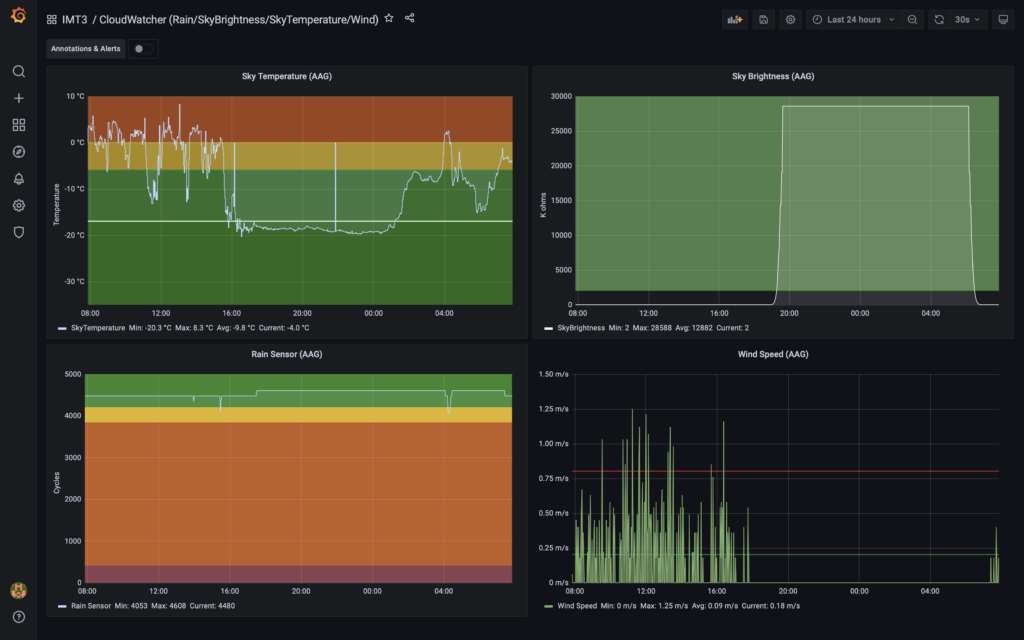

Viewing Report 24th September 2021 – IMT3
20:46 – 21:39
NGC 6765, second attempt
Viewing Report 11th September 2021 – IMT3
22:35 – 23:45
Focus position 18464
Temp -25℃
Gain 139 Offset 21
OIII LRGB 20 x each, 600s on OIII and L and then 300s on RGB
Rotation angle 29.420
NGC 6765 planetary nebula in Lyra
Everything up until 23:45 is Luminance as the filter wheel was not connected correctly in SGPro and it thought it was moving but did not…..
Went to bed
Looks like it clouded over around midnight so a few images only. I also now seem to have a mark on the Luminance filter at the bottom which is a pain, not sure how that got there on a closed system. Also the scope must have moved during the imaging as a few of the images are of a different FoV.
Viewing Report 7th September 2021 – IMT3b
21:32 – 06:07
M71 Globular Cluster.
Focus position 14,563
Rotator Position 29.420
Temp -22℃
Gain 75 Offset 12
LRGB started at 22:14
Focuser position on last image 16,636
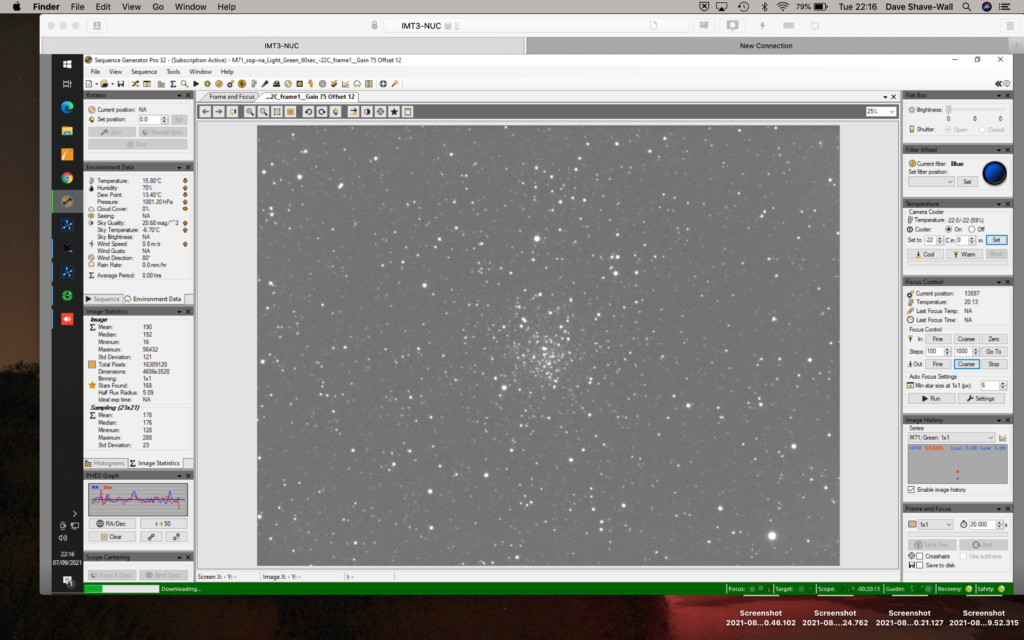

Viewing Report 6th September 2021 – IMT3b
17:35 – 22:15
Opened dome early to cool down, we then had some cloud and it closed, so reopen around 8pm.
As it has been a very warm day, some 28℃ and is still 20℃s, I will set the camera temp to -20℃ and image a different object to avoid several sets of flats, darks and flat darks. I settled on M56 as I had not imaged this for my Messier catalogue yet.
Loads of problems, mount kept saying it was not unpacked, guider would not connect, so rebooted and all fine.
Imaging at 22:10
Gain 75 Offset 12
Rotation angle 29.420
Temp -22 (need correct Flats/Darks and Dark Flats)
When I rebooted I noticed the PHD2 setting are wrong for the guider so need to change the profile to include DirectGuide not Pulse Guide. Also need to change SGPro so that it does not autofocus at the start of a run, also so it does not set the temp to -15.
Off to bed at 22:15 and left it running.
Everything went well, the dome shut at sunrise and the images look ok, maybe slightly soft focus but only when I process will I be able to tell.

